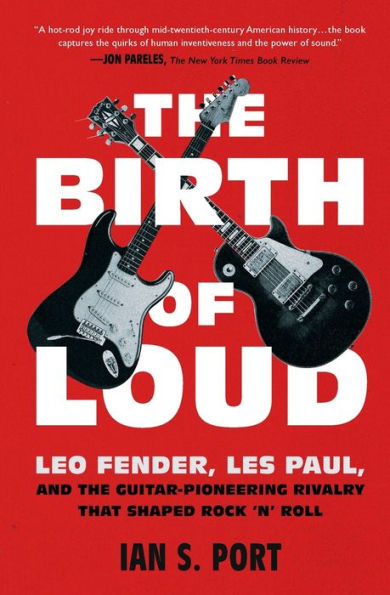In the years after World War II, music was evolving from big-band jazz into rock ’n’ roll—and these louder styles demanded revolutionary instruments. When Leo Fender’s tiny firm marketed the first solid-body electric guitar, the Esquire, musicians immediately saw its appeal. Not to be out-maneuvered, Gibson, the largest guitar manufacturer, raced to build a competitive product. The company designed an “axe” that would make Fender’s Esquire look cheap and convinced Les Paul—whose endorsement Leo Fender had sought—to put his name on it. Thus was born the guitar world’s most heated rivalry: Gibson versus Fender, Les versus Leo.
While Fender was a quiet, half-blind, self-taught radio repairman, Paul was a brilliant but headstrong pop star and guitarist who spent years toying with new musical technologies. Their contest turned into an arms race as the most inventive musicians of the 1950s and 1960s—including bluesman Muddy Waters, rocker Buddy Holly, the Beatles, Bob Dylan, and Eric Clapton—adopted one maker’s guitar or another. By 1969 it was clear that these new electric instruments had launched music into a radical new age, empowering artists with a vibrancy and volume never before attainable.
In “an excellent dual portrait” (The Wall Street Journal), Ian S. Port tells the full story in The Birth of Loud, offering “spot-on human characterizations, and erotic paeans to the bodies of guitars” (The Atlantic). “The story of these instruments is the story of America in the postwar era: loud, cocky, brash, aggressively new” (The Washington Post).
In the years after World War II, music was evolving from big-band jazz into rock ’n’ roll—and these louder styles demanded revolutionary instruments. When Leo Fender’s tiny firm marketed the first solid-body electric guitar, the Esquire, musicians immediately saw its appeal. Not to be out-maneuvered, Gibson, the largest guitar manufacturer, raced to build a competitive product. The company designed an “axe” that would make Fender’s Esquire look cheap and convinced Les Paul—whose endorsement Leo Fender had sought—to put his name on it. Thus was born the guitar world’s most heated rivalry: Gibson versus Fender, Les versus Leo.
While Fender was a quiet, half-blind, self-taught radio repairman, Paul was a brilliant but headstrong pop star and guitarist who spent years toying with new musical technologies. Their contest turned into an arms race as the most inventive musicians of the 1950s and 1960s—including bluesman Muddy Waters, rocker Buddy Holly, the Beatles, Bob Dylan, and Eric Clapton—adopted one maker’s guitar or another. By 1969 it was clear that these new electric instruments had launched music into a radical new age, empowering artists with a vibrancy and volume never before attainable.
In “an excellent dual portrait” (The Wall Street Journal), Ian S. Port tells the full story in The Birth of Loud, offering “spot-on human characterizations, and erotic paeans to the bodies of guitars” (The Atlantic). “The story of these instruments is the story of America in the postwar era: loud, cocky, brash, aggressively new” (The Washington Post).

The Birth of Loud: Leo Fender, Les Paul, and the Guitar-Pioneering Rivalry That Shaped Rock 'n' Roll
352
The Birth of Loud: Leo Fender, Les Paul, and the Guitar-Pioneering Rivalry That Shaped Rock 'n' Roll
352Paperback(Reprint)

Product Details
| ISBN-13: | 9781501141737 |
|---|---|
| Publisher: | Scribner |
| Publication date: | 11/19/2019 |
| Edition description: | Reprint |
| Pages: | 352 |
| Product dimensions: | 5.40(w) x 8.30(h) x 1.00(d) |
Customer Reviews
Explore More Items
The cryptocurrency market moves quickly and miners and investors need the latest information to stay ahead of the game. This
Fine art might seem intimidating at first. But with the right guide, anyone can learn to appreciate and understand the
Looking to kick start your own property management career? Check out Foreclosure Investing For Dummies, which
Nothing seems to change faster than an iPhone. Just when you think you know your way around the device, a new update arrives and you
One of the most revered voices in literature today gives us a story of love, friendship, and heartbreak for the ages.
Colorless Tsukuru Tazaki and His Years
The definitive rock encyclopedia for the 21st century updated for the ever-changing world of music.
"An absolute must for any rock-music fan."
—Booklist
"A welcome and heavily used addition
—New
A New York Times Book Review Top Ten Book of the Year
Time magazine Top Ten Nonfiction Book of 2007
Newsweek Favorite Books of 2007
A
How Music Works is David Byrne’s incisive and enthusiastic look at the musical art form, from its very inceptions to the influences that shape
